|
The Film

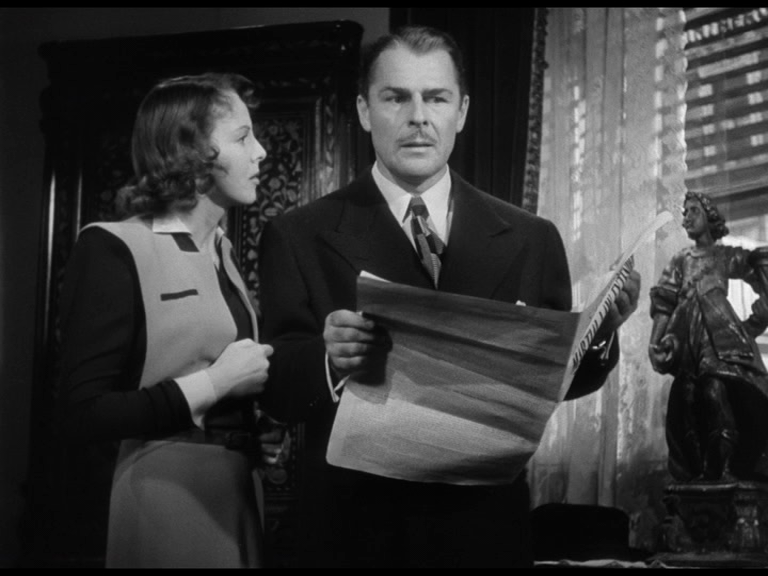 Hangmen Also Die! (Fritz Lang, 1943) Hangmen Also Die! (Fritz Lang, 1943)
Based on a true story, Hangmen Also Die! (1943) sits alongside the other Hollywood films Austrian émigré director Fritz Lang made during the 1940s about the dangers of the Nazi ideology. These other films were, of course, Man Hunt (1941), Lang’s adaptation of Graham Greene’s novel The Ministry of Fear (1944), and Cloak and Dagger (1946). Peter Bogdanovich has argued that these four films ‘are characterized by an intense personal involvement, a vivid awareness of the fascist mind, missing from other similar movies of that era’ (Bogdanovich, 1997: np).
Hangmen Also Die! begins with Reinhard Heydrich (Hans Heinrich von Twardowski), head of the occupying forces in Czechoslovakia, responding to complaints by the Gestapo that the local factory workers, who have been railroaded by the occupying Nazi forces into producing munitions for the German war effort, have been deliberately slowing down their labours and, in some cases, even sabotaging the munitions that they are making. During a visit to the Skoda plants where the munitions are being made, Heydrich is assassinated. His killer, a member of the Czech underground, is scientist Dr Franticek Svoboda (Brian Donlevy).
Whilst fleeing from the Gestapo, Svoboda encounters Masha Novotny (Anna Lee), who assists Svoboda by sending his pursuers in the opposite direction to which he has fled. Returning home, Masha confides in her father, former revolutionary Professor Stephen Novotny, that she protected Heydrich’s killer. Happy that Heydrich has been assassinated, Professor Novotny tells Masha that under no circumstances must she tell this story to anyone else – not even her fiancé, Jan Horak (Dennis O’Keefe).
 However, matters become increasingly complicated when Svoboda, who has found it impossible to find shelter before the Nazi-imposed curfew hits the city, turns up on the doorstep of the Novotny family. Masha allows him entry into the house, and Professor Novotny offers Svoboda shelter during the hours of the curfew. When Masha cuts her finger at the dinner table, Svoboda tends to her injury, and Masha develops an increasing sense of empathy with Svoboda. However, matters become increasingly complicated when Svoboda, who has found it impossible to find shelter before the Nazi-imposed curfew hits the city, turns up on the doorstep of the Novotny family. Masha allows him entry into the house, and Professor Novotny offers Svoboda shelter during the hours of the curfew. When Masha cuts her finger at the dinner table, Svoboda tends to her injury, and Masha develops an increasing sense of empathy with Svoboda.
Meanwhile, the Gestapo believe they are close to identifying Heydrich’s assassin. They interview a vegetable seller who was with Novotny when she sent the Gestapo officers in the opposite direction to Svoboda. Unwilling to help the Gestapo, the vegetable seller nevertheless finds herself unable to resist the cruel methods of the officer in charge of the investigation, Alois Gruber (Alexander Granach).
Soon after, the Gestapo arrest Professor Novotny, vowing to hold him until the assassin identifies himself. Novotny is placed in a camp with four hundred other ‘undesirables’ – members of the underground. His conscience pricked by the Gestapo’s imprisonment of these men, Svoboda speaks with his contact, who insists that ‘We anticipated hostages’ in retaliation for Heydrich’s assassination. However, Svoboda is persuaded not to turn himself in to the Gestapo: to do so, he is told, would undermine the symbolic importance of the assassination of Heydrich, leading to a perception that the occupying forces have ‘won’. Nevertheless, when the Gestapo begin to assassinate the hostages they have taken, and then increasing the number of daily executions, Masha believes Svoboda to have betrayed her father and seeks to collaborate with the Gestapo.
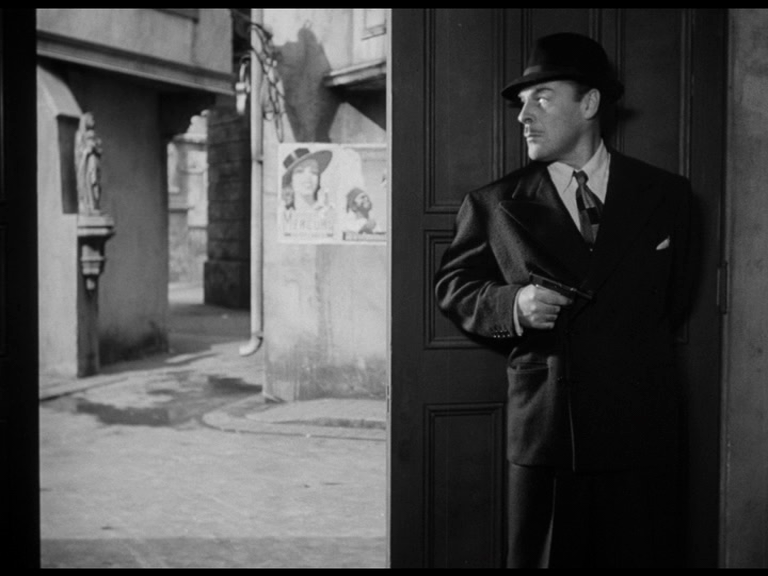 The film opens with onscreen text which establishes a context for the narrative that follows, identifying the setting of the narrative: Czechoslovakia during the Nazi occupation. Heydrich is also introduced in this text, which tells us his ‘reign of terror caused people to call him “The Hangman”. He issued orders of death from the Hradzin Castle that overlooks old Prague, capital of unhappy but unbeaten Czechoslovakia’. The sadism of the occupying forces is established early in the film, firstly via Heydrich’s manipulative treatment of his own officers (outlined in the paragraph above) and, slightly later, by Gruber’s cruel interrogation of the vegetable seller. ‘Do you realise where you are?’, Gruber asks the peddler in a soft voice which makes his threats all the more menacing, ‘And you actually believe you‘ll walk out of her without telling us the truth?’ The film opens with onscreen text which establishes a context for the narrative that follows, identifying the setting of the narrative: Czechoslovakia during the Nazi occupation. Heydrich is also introduced in this text, which tells us his ‘reign of terror caused people to call him “The Hangman”. He issued orders of death from the Hradzin Castle that overlooks old Prague, capital of unhappy but unbeaten Czechoslovakia’. The sadism of the occupying forces is established early in the film, firstly via Heydrich’s manipulative treatment of his own officers (outlined in the paragraph above) and, slightly later, by Gruber’s cruel interrogation of the vegetable seller. ‘Do you realise where you are?’, Gruber asks the peddler in a soft voice which makes his threats all the more menacing, ‘And you actually believe you‘ll walk out of her without telling us the truth?’
The film is to some extent about the burden of goodwill: arriving on the Novotnys’ doorstep, seeking shelter during the hours of the curfew, Svoboda begs Masha, ‘You’ve helped me once before, Miss Novotny’. When the Gestapo, in response to the assassination of Heydrich, take four hundred men hostage before beginning to execute a number of them each day, Svoboda is faced with an impenetrable moral dilemma: surrender himself to the Gestapo, and thereby potentially save these hostages whilst also undermining the symbolic potential of his assassination of Heydrich, or remain in hiding whilst the Gestapo execute their hostages. Svoboda’s decision isn’t motivated by self-preservation: he proposes killing himself and writing a note for the Gestapo in which he will confess to killing Heydrich. However, his contact within the underground tells Svoboda that he was ‘chosen to act as a representative of the Czech people. The Czech people have executed The Hangman [Heydrich] [….] What is four hundred lives? This is a war of millions. And this execution of Heydrich is only one battle in that war, but a most important one. But if you surrender yourself, alive or dead, the Czech people will not have won that battle. Every Czech will say, “We must not resist: the Gestapo is too much for us”’. However, Masha believes that Svoboda must turn himself in to the Gestapo in order to save her father and the other hostages: ‘They’ll kill him [her father] for what you did’, she reminds Svoboda, adding that ‘We are lost in any case because we were generous enough to save your life. You’re just a cold-blooded coward. You’re not better than Heydrich himself. Even the Gestapo couldn’t be as inhuman as you are’.
 When the Gestapo begin executing the hostages, and the life of her father becomes threatened, Masha becomes alienated from the underground and, at least initially, seeks to assist the Gestapo in capturing Svoboda. However, on her way to the castle which the Gestapo have made their headquarters, asking for directions to where she may find Alois Gruber, she is stopped by other members of the public; a mocking crowd forms around her, and she is asked, ‘If they [the Gestapo] didn’t send for you, what business do you want with those butchers?’ ‘Who are you squealing on, you little Judas?’, another voice asks Masha. Masha’s father insists that she must protect Heydrich’s assassin, but unlike Svoboda – who battles with his own desire to turn himself in – Masha is motivated by a form of self-interest, seeking to protect her father and prevent him from being executed. For his part, her father insists that turning Svoboda in to the Gestapo will do no good. In the camp where the hostages are being held, one of the men asserts that Heydrich’s killer should be caught: ‘It’s not only a question of saving the three hundred of us still alive. But after we’re shot, what then? There’ll be another three hundred, then three thousand. There will be no end until they get the assassin’. ‘There’ll be no end anyway’, Novotny declares in response, ‘They [the Gestapo] never needed a beginning. They slaughtered thousands long before Heydrich, just for breathing Czech air’. When the Gestapo begin executing the hostages, and the life of her father becomes threatened, Masha becomes alienated from the underground and, at least initially, seeks to assist the Gestapo in capturing Svoboda. However, on her way to the castle which the Gestapo have made their headquarters, asking for directions to where she may find Alois Gruber, she is stopped by other members of the public; a mocking crowd forms around her, and she is asked, ‘If they [the Gestapo] didn’t send for you, what business do you want with those butchers?’ ‘Who are you squealing on, you little Judas?’, another voice asks Masha. Masha’s father insists that she must protect Heydrich’s assassin, but unlike Svoboda – who battles with his own desire to turn himself in – Masha is motivated by a form of self-interest, seeking to protect her father and prevent him from being executed. For his part, her father insists that turning Svoboda in to the Gestapo will do no good. In the camp where the hostages are being held, one of the men asserts that Heydrich’s killer should be caught: ‘It’s not only a question of saving the three hundred of us still alive. But after we’re shot, what then? There’ll be another three hundred, then three thousand. There will be no end until they get the assassin’. ‘There’ll be no end anyway’, Novotny declares in response, ‘They [the Gestapo] never needed a beginning. They slaughtered thousands long before Heydrich, just for breathing Czech air’.
Set against this main narrative is a subplot involving a member of the underground, Emil Czaka (Gene Lockhart), who it is revealed is working as a double agent, collaborating with the Gestapo. After the Gestapo reveal their plan to execute the hostages, Emil is shown at a meeting of the underground, suggesting that the executions will lead the people of Prague to turn against the resistance effort. (The sentiment behind his words has, of course, been planted by the Nazi occupiers.) Later, dining with Alois Gruber, Emil is shown declaring that ‘Our entire future depends on unconditional collaboration with great Germany’. The other members of the underground finally realise that Emil is a collaborator when one of them tells a joke, in German (a language Emil claims not to understand), about Hitler. Emil laughs, unconsciously revealing that he comprehended the joke. Fleeing from his former comrades, Emil is finally enlisted by the Gestapo to assist in the intimidation and interrogation of members of the underground, demonstrating a level of sadism to equal that exhibited by Gruber.
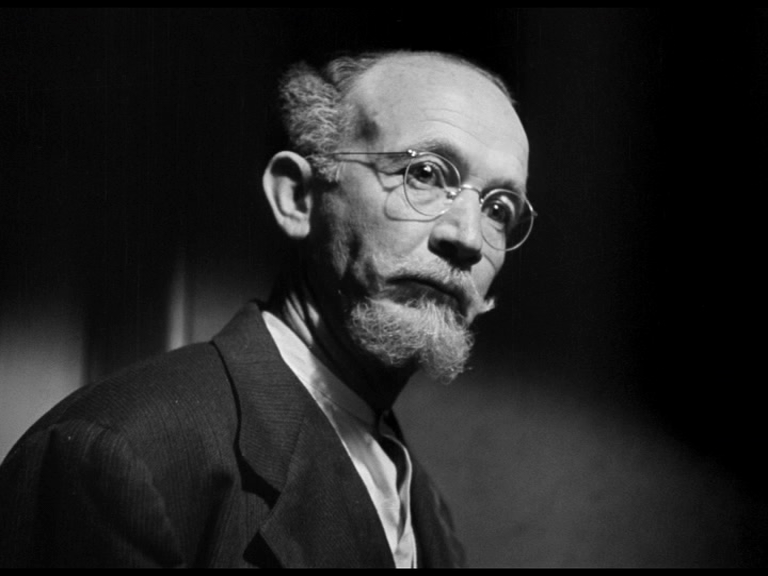 Hangmen Also Die! was rooted in the true story of the assassination in 1942 of the commander of the occupying Nazi forces in Czechoslovakia, Reichsprotektor Reinhard Heydrich. Heydrich was killed in the Czech town of Lidice, and in response the occupying Nazi forces resorted to increasingly cruel measures in order to force the populace into identifying Heydrich’s assassin. In exploring directly the theme of Nazism and the eradication of an individual who is seen as the symbol of that ideology, the picture has been seen in some ways as a response to Lang’s earlier Mabuse films, with Lang himself suggesting that ‘out of the Mabuses came the Heydrichs, the Himmlers and Hitlers’ (Lang, quoted in Kalat, 2001: 73). Somewhat ironically, Lang’s earlier picture The Testament of Dr Mabuse (1933) wasn’t released in the US until the same year as the production of Hangmen Also Die!, and promoting the latter film Lang argued that in The Testament of Dr Mabuse he was offering ‘an allegory of Hitler’s processes of terror’, ‘putting all the Nazi slogans into the mouth of criminals’ (Lang, quote in ibid.: 73-4). Hangmen Also Die! was rooted in the true story of the assassination in 1942 of the commander of the occupying Nazi forces in Czechoslovakia, Reichsprotektor Reinhard Heydrich. Heydrich was killed in the Czech town of Lidice, and in response the occupying Nazi forces resorted to increasingly cruel measures in order to force the populace into identifying Heydrich’s assassin. In exploring directly the theme of Nazism and the eradication of an individual who is seen as the symbol of that ideology, the picture has been seen in some ways as a response to Lang’s earlier Mabuse films, with Lang himself suggesting that ‘out of the Mabuses came the Heydrichs, the Himmlers and Hitlers’ (Lang, quoted in Kalat, 2001: 73). Somewhat ironically, Lang’s earlier picture The Testament of Dr Mabuse (1933) wasn’t released in the US until the same year as the production of Hangmen Also Die!, and promoting the latter film Lang argued that in The Testament of Dr Mabuse he was offering ‘an allegory of Hitler’s processes of terror’, ‘putting all the Nazi slogans into the mouth of criminals’ (Lang, quote in ibid.: 73-4).
When approached to make Hangmen Also Die!, Lang asked Bertolt Brecht to help him with the writing of the picture (along with John Wexley), Lang having helped Brecht raise the finances required to escape Nazi Germany. However, Lang and Brecht soon found themselves at loggerheads, with Brecht ‘want[ing] the film to be a grand paean to the power of the people’ whilst Lang ‘had spent his career showing how easily “the people” can be turned into a vicious mob’ (Kalat, op cit.: 99). Brecht wanted to cast some of his friends, including his wife, in the picture, but Lang prevented this from taking place; and Brecht took issue with Lang’s attempts to craft a popular, commercially successful film, arguing that Lang ‘sits with all the airs of a dictator […] behind his boss-desk, full of drugs, and resentment at any good suggestions, collecting “suprises”, little bits of nonsense, tawdry sentimental touches and falsehoods, and takes “licenses” for the box office’ (Brecht, quoted in ibid.). (Brecht’s recollections of Lang’s attitude chime somewhat with those of the film’s lead actress Anna Lee, who claimed that Lang was ‘a sick man, obviously on drugs’ who subjected her to a some extremely cruel behaviour on the set of the film, including demanding that she punch through a glass pane with her hand repeatedly, until she cut herself; Lee, quoted in Mank, 2014: 315). The experience left Brech feeling ‘the disappointment and terror of the intellectual worker who sees the product of his labors snatched away and mutilated’ (Brecht, quoted in Kalat, op cit.: 99).
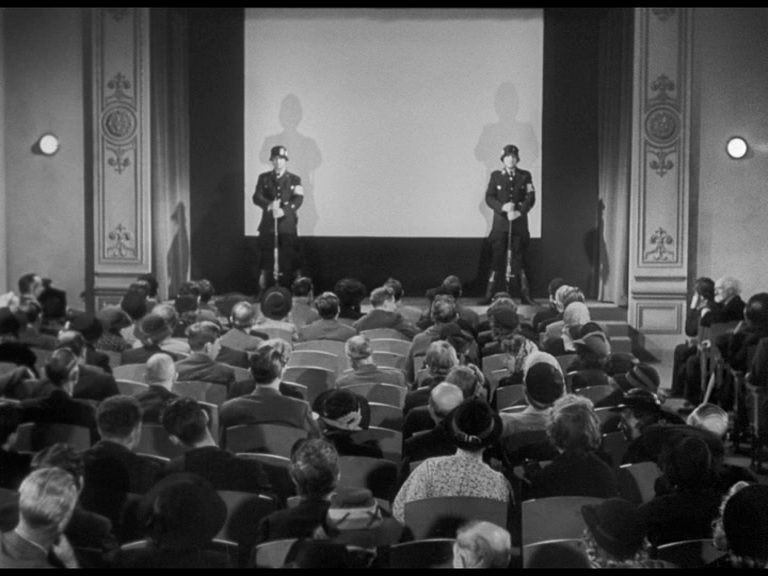 The killing of Heydrich isn’t shown on screen, and in fact Heydrich himself appears only in an early scene in which he is shown in Hradzin Castle, listening to the concerns of the Gestapo officers who complain that the Czech workers, who have been forced by the Gestapo to aid in the production of munitions for the Axis forces, are being bombarded with anti-Nazi propaganda telling them to slow down in their labours. In this scene, Heydrich is frequently framed in front of a huge portrait of Hitler, holding court and carrying himself in a manner which suggests a barely-concealed sense of perversion. When Heydrich enters the room, he ‘tests’ the subservience of one of the Gestapo officers by dropping his riding crop in front of the other man and waiting for him to pick up the item and hand it back to its owner. (In this context, given Heydrich’s prissy demeanour, the riding crop seems to take on obvious Freudian symbolic potential.) The killing of Heydrich isn’t shown on screen, and in fact Heydrich himself appears only in an early scene in which he is shown in Hradzin Castle, listening to the concerns of the Gestapo officers who complain that the Czech workers, who have been forced by the Gestapo to aid in the production of munitions for the Axis forces, are being bombarded with anti-Nazi propaganda telling them to slow down in their labours. In this scene, Heydrich is frequently framed in front of a huge portrait of Hitler, holding court and carrying himself in a manner which suggests a barely-concealed sense of perversion. When Heydrich enters the room, he ‘tests’ the subservience of one of the Gestapo officers by dropping his riding crop in front of the other man and waiting for him to pick up the item and hand it back to its owner. (In this context, given Heydrich’s prissy demeanour, the riding crop seems to take on obvious Freudian symbolic potential.)
Video
Please note that for the purposes of this review, we were provided only with the DVD copy included in the package.
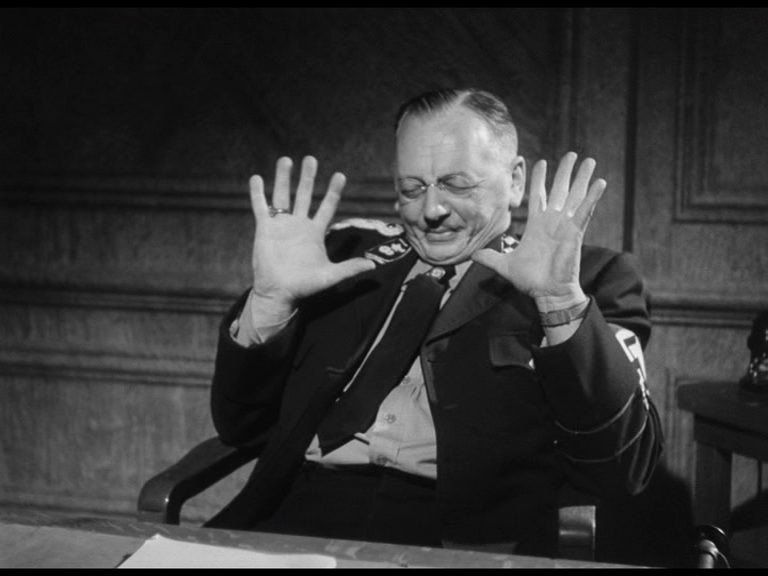 Running 130:05 mins (PAL) on the DVD, Hangmen Also Die! is presented in the film’s original Academy aspect ratio (1.37:1). This presentation is based on the 2012 restoration of the film, which reinstated some of the footage cut from original release prints of the film. The restoration seems to be a composite of sorts, using various sources to present as complete a version of the film as possible, and thus there’s some inconsistency in the presentation. However, it looks remarkably good, the careful lighting and beautiful compositions of cinematographer James Wong Howe (inarguably one of the greatest cinematographers in the history of Hollywood cinema) being strongly represented here. Contrast levels are good, with a pleasing balance of light and shadow and defined midtones in the monochrome photography. Some sequences display density fluctuations in the emulsions, but this is a minor issue. There are a small handful of jump cuts here and there, presumably owing to print damage. However, on the whole the presentation is remarkably clean and very pleasing. Running 130:05 mins (PAL) on the DVD, Hangmen Also Die! is presented in the film’s original Academy aspect ratio (1.37:1). This presentation is based on the 2012 restoration of the film, which reinstated some of the footage cut from original release prints of the film. The restoration seems to be a composite of sorts, using various sources to present as complete a version of the film as possible, and thus there’s some inconsistency in the presentation. However, it looks remarkably good, the careful lighting and beautiful compositions of cinematographer James Wong Howe (inarguably one of the greatest cinematographers in the history of Hollywood cinema) being strongly represented here. Contrast levels are good, with a pleasing balance of light and shadow and defined midtones in the monochrome photography. Some sequences display density fluctuations in the emulsions, but this is a minor issue. There are a small handful of jump cuts here and there, presumably owing to print damage. However, on the whole the presentation is remarkably clean and very pleasing.
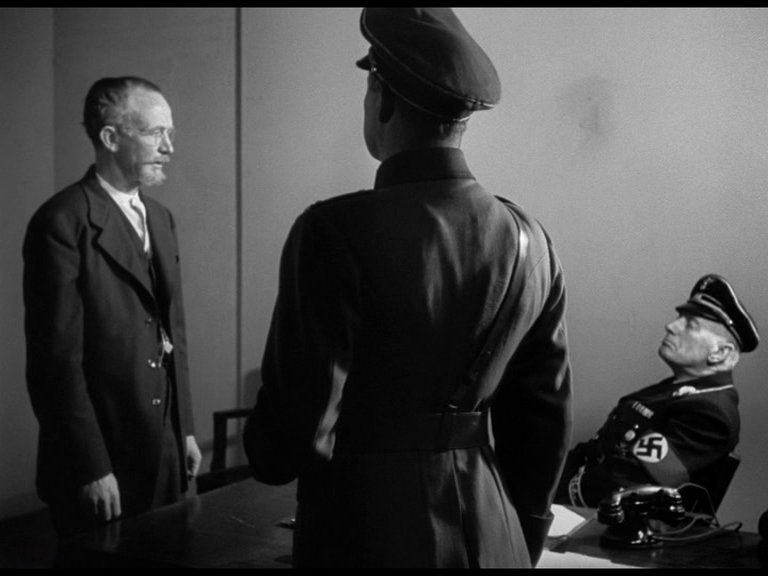 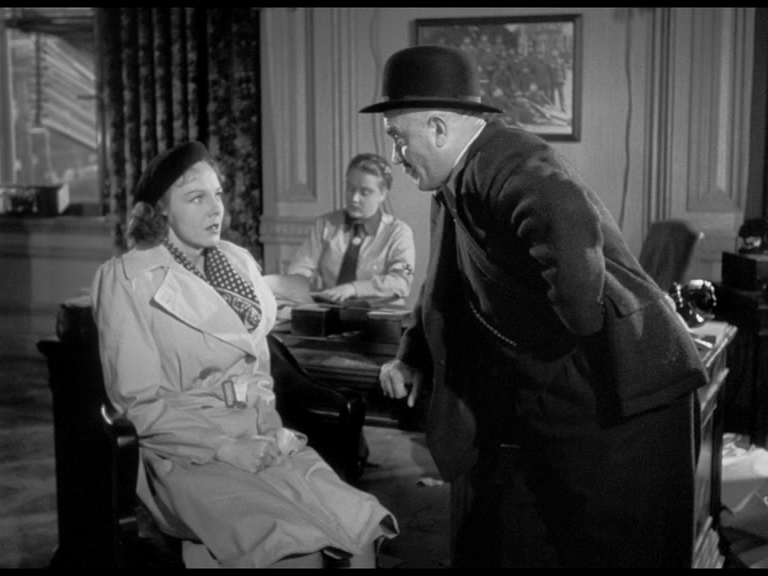 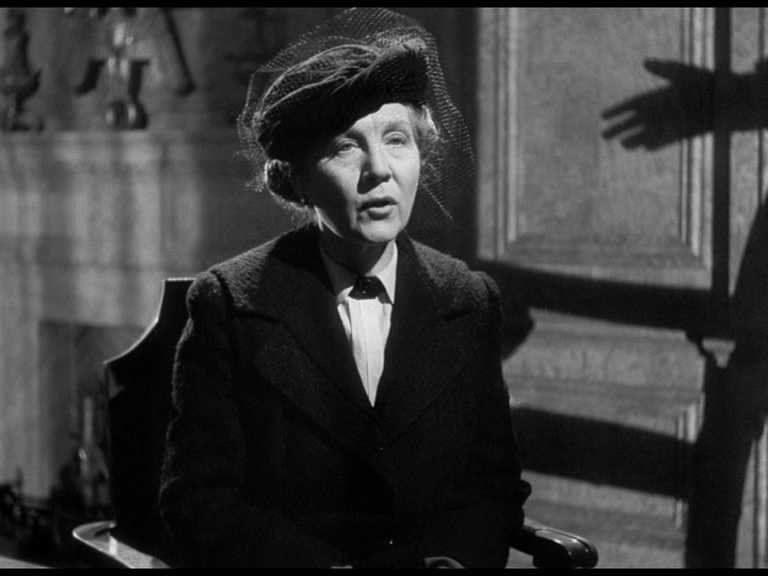
Audio
Audio, on the DVD presented for review, is via a Dolby Digital 1.0 mono track, with accompanying optional English subtitles for the Hard of Hearing. The audio track is clear throughout, and dialogue is always audible. The subtitles are error free and easy to read.
Extras
The disc includes:
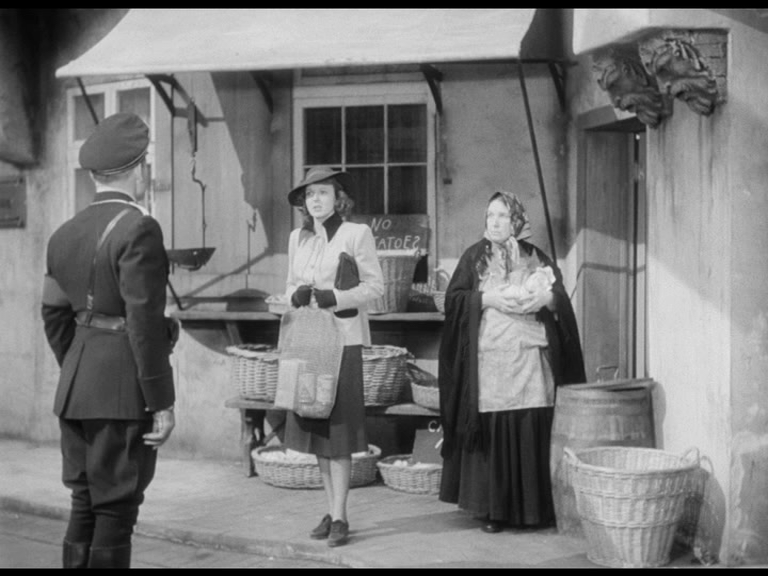 - A commentary with film historian Richard Peña. In a thorough commentary track, Peña discusses the film in a great amount of detail, discussing some of the themes examined in the picture and contextualising the film by situating it within the work of Lang and Brecht and discussing the input of James Wong Howe and the various performers. - A commentary with film historian Richard Peña. In a thorough commentary track, Peña discusses the film in a great amount of detail, discussing some of the themes examined in the picture and contextualising the film by situating it within the work of Lang and Brecht and discussing the input of James Wong Howe and the various performers.
- ‘Story of a Hangman: Robert Gerwath on Reinhard Heydrich’ (27:24). Here, Gerwath, the author of a book about Heydrich, discusses the film’s relationship with the real-life story of Heydrich’s assassination.
- Restoration Comparison (4:50). This short piece provides ‘before and after’ samples to show some of the work that went into restoring the film.
- Trailer (1:42).
Overall
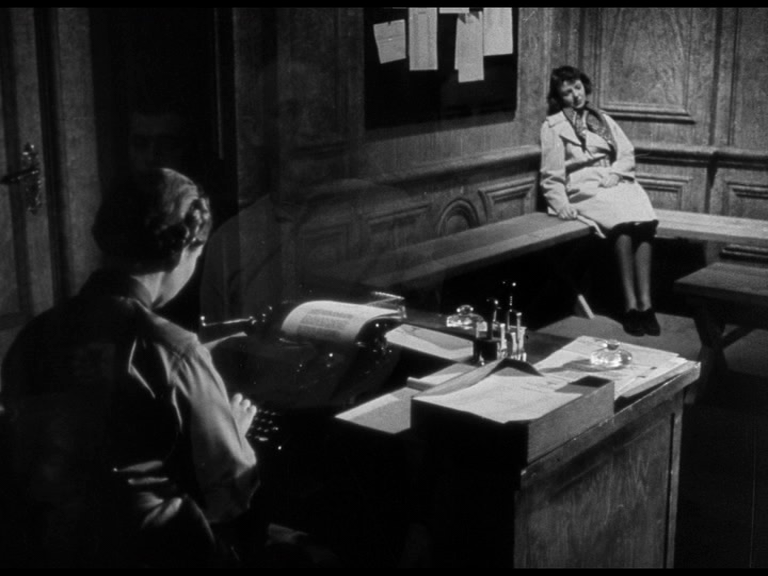 Hangmen Also Die! is a film that poses a series of complex moral dilemmas, narrativised through Svoboda’s plight (he wishes to turn himself in to protect the hostages taken by the Gestapo, but realises that to do so would undermine the resistance) and Masha’s response to it (despite her father’s protestations that she must protect Svoboda, Masha battles with her desire to turn Svoboda in to the occupying forces in exchange for her father’s life). The Gestapo are cruel (‘Marvelous people, these Czechs’, Gruber declares spitefully at one point, ‘Stubborn to the end. The bitter end’) and their methods are, they believe, infallible. The pivot of the film, perhaps, is a scene in which Novotny narrates to Masha a letter intended for Masha’s younger brother Beda (William Roy); it’s a letter which Novotny believes if it were to be written down, would surely be censored by the Gestapo. Novotny declares that he hopes Beda will be living in an era when the ‘now mighty invaders will have been thrown out of our land for quite some time. I hope you will be living in a free land where the people are truly governed by themselves and for themselves [….] When such great days do come, don’t forget that freedom is not something one possesses, like a hat or a piece of candy. The real thing is fighting for freedom’. Hangmen Also Die! is a film that poses a series of complex moral dilemmas, narrativised through Svoboda’s plight (he wishes to turn himself in to protect the hostages taken by the Gestapo, but realises that to do so would undermine the resistance) and Masha’s response to it (despite her father’s protestations that she must protect Svoboda, Masha battles with her desire to turn Svoboda in to the occupying forces in exchange for her father’s life). The Gestapo are cruel (‘Marvelous people, these Czechs’, Gruber declares spitefully at one point, ‘Stubborn to the end. The bitter end’) and their methods are, they believe, infallible. The pivot of the film, perhaps, is a scene in which Novotny narrates to Masha a letter intended for Masha’s younger brother Beda (William Roy); it’s a letter which Novotny believes if it were to be written down, would surely be censored by the Gestapo. Novotny declares that he hopes Beda will be living in an era when the ‘now mighty invaders will have been thrown out of our land for quite some time. I hope you will be living in a free land where the people are truly governed by themselves and for themselves [….] When such great days do come, don’t forget that freedom is not something one possesses, like a hat or a piece of candy. The real thing is fighting for freedom’.
The presentation of the film here is very good indeed, and the main feature is accompanied by some strong contextual material.
References:
Bogdanovich, Peter, 1997: Who the Devil Made It. New York: Ballantine Books
Kalat, David, 2001: The Strange Case of Dr Mabuse: A Study of the Twelve Films and Five Novels. London: McFarland & Company, Inc
Mank, Gregory William, 2014: The Very Witching Time of Night: Dark Alleys of Classic Horror Cinema. London: McFarland & Company, Inc
Skolnik, Jonathan, 2012: ’28 May 1942: Bertolt Brecht and Fritz Lang Write a Hollywood Screenplay’. In: Kapczynski, Jennifer M & Richardson, Michael David (eds), 2012: A New History of German Cinema. New York: Camden House: 288-93
|


